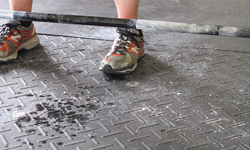If you’re working on improving your vision, you’re probably into self-improvement in general and would like to be in better physical shape. But as with vision improvement, you might be frustrated with figuring out the right way to do it, and nothing seems to work very well.
So here are some basics that the vast majority of people don’t know. Any athletic trainer would know this stuff. A lot of regular workout junkies who have kept up on trends (ie: they aren’t stuck in the mindset of decades ago) know this stuff and much more. This is just a basic rundown of a few bits of modern knowledge to knock a few misconceptions out of your head that are relics from when very little was understood about training. Like the FDA’s horrible diet recommendations as I went over in my last post, the traditional wisdom on workout programs is pretty bad.
Most of what you hear about a good exercise program is wrong. Most of what you see people doing at the 24 Hour Fitness, Gold’s Gym, or Bally’s is a painful waste of time and isn’t helping them achieve their goals.
CARDIO AND WEIGHT TRAINING
Conventional wisdom from decades ago says that a great workout program consists of 30-45 minutes of weight training and 30-45 minutes of cardio, give or take. To burn fat, the wisdom is to do more cardio. The heavily-promoted “fat burning zone” for cardio workouts will have you doing long, boring, low-intensity cardio each session. People have had to resort to listening to music or watching TV just to get through it. Some people enjoy it, and if that’s the case, great, but the majority of people don’t, shown by the huge dropout rate. Come January, there’s crowds of New Year’s resolutioners that last a few weeks, start to falter in their commitment, then disappear altogether by Summer. The fat burning zone works somewhat, but it isn’t the best method.
So what to do?
You likely have a few problems starting out. Some of your muscles are weak, your body isn’t accustomed to athletic movements with good form, you have muscle knots causing stiffness and pain, you have bad circulation, and your energy is probably low. If you do physical labor for a living, you can easily have an imbalance, favoring certain muscles to the detriment of good body mechanics, and working around stiffness and pain. Any of the above is the typical middle aged person who has been preoccupied with raising a family, their job, other hobbies, etc, and neglected their body.
The first thing to do is to just start moving. If you lift freeweights with bad form, you are likely to hurt yourself. If you use weight machines only, you won’t accomplish much. So I’m talking a lot of bodyweight exercises and light weights. Girl pushups, sit ups, assisted pull ups, assisted dips, aerobics, jogging, kettlebell exercises, or a hundred different Crossfit exercises. There’s a ton of stuff you can do with little or no equipment, scaled as appropriate to your abilities. The point is to learn the common body mechanics through all movements to protect your back and move efficiently, and get yourself used to doing a workout. The most important thing is to avoid any weight machines at first, because you need to learn how to use your body better first. And you will continue to do some of these things before every workout as a warm-up.
And stretching, foam rolling and trigger point therapy are invaluable for everyone at all levels. It’s part of just fixing the body up to get into basic shape to be used instead of just deteriorating.
THE METCON
Once you’ve got all that started, the #1 routine that almost everyone should incorporate into their workout is the metcon, short for metabolic conditioning. Crossfit has popularized it. but you don’t have to do it the way Crossfitters do. Change it up and make it your own. It’s the kind of workout where the exercise is simple enough for you to do each rep quickly, light enough for you to do lots of reps, hard enough (with added weight, when appropriate) that you get your lungs and heart going, and simple enough that your form doesn’t break too badly as you get gassed. What the metcon really means is full-tilt, high-intensity, where you keep going even though you want to quit the first minute in, and when the timer buzzes you end it by falling to the floor and lying in a pool of your own sweat, impressed with yourself that you could keep going when you thought you were done. Then you get up and repeat.
Here are a couple good examples.
It may sound tough, but this is basic conditioning for everyone, not just athletes. A metcon will do a little to build both strength and muscle, and you will lose fat (combined with the right diet)_ more quickly than long cardio while retaining muscle, but its overall purpose is to make your body function better in all ways. The effects on your body from metcons will make everything else in your life easier. I’m talking everything from strength training to bike riding to just getting through a work day without being exhausted.
You’ll see a lot of metcons ranging from 7 to 15 minutes. However, Robb Wolf makes a case for a short 3-minute metcon that makes perfect sense to me. If you find yourself slowing down or taking a breather to pace yourself, you should shorten it to 3 minutes so you can stay at maximum intensity until the buzzer hits. Then you can repeat it for another 3 minutes, until you feel like you’ve gotten a kick-ass workout.
From there, you can specialize as your goals dictate, whether it’s adding strength, muscle, fixing specific problems or weaknesses, or sports training. But with the metcon you’ve fulfilled your cardio requirement in a fraction of the time of what people think they need to do. Even if you do nothing but metcons, you’ll keep getting in better shape.
And what does this have to do with vision improvement? The body is a unit, and it shouldn’t surprise you that if one aspect is deteriorating it may affect other parts of your body, including your eyes and brain. And the same themes in learning to use your body right translate into learning to use your eyes right. You learn to relax your muscles. You learn to perform only the appropriate amount of effort to accomplish a task. You learn to stay focused, set goals, and not give up. And of course better circulation and relaxed muscles will mean that you don’t have such a general pattern of tension that your eyes will get caught up in. And you’ll have confidence that you’re actually in control of your body and can figure this whole vision improvement thing out.
get help on our Facebook Group!
I founded iblindness.org in 2002 as I began reading books on the Bates Method and became interested in vision improvement. I believe that everyone who is motivated can identify the roots of their vision problems and apply behavioral changes to solve them.


